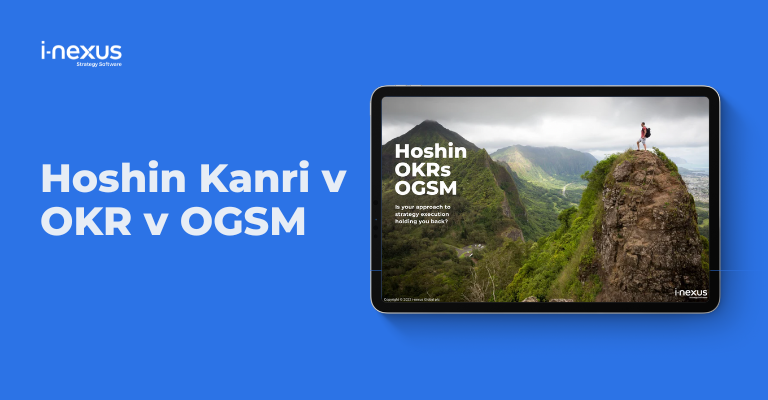What is Hoshin Kanri? This is a frequently asked question, and this blog explores its origins, the seven steps of execution, common fail points, resources, and more to help your organization succeed in driving breakthrough results from plans.
Written by: Carolyn Gibson, Senior Strategy Advisor
Hoshin Kanri is a process that organizations use to develop their long-term strategy into concrete plans, and then execute that strategy over time.
“If you don’t know where you are going, you’ll end up someplace else.”
Yogi Berra
What is Hoshin Kanri?
Hoshin Kanri means “policy management” in Japanese. The characters use elements of the words ‘compass’ and ‘direction’, with the obvious implication that you need to know where you are going and a map to get there.
In times of hyper-competition, environmental challenges, shifting political landscape, and ever-transforming technologies, you may wonder why you should discuss planning, maps, and direction. We are in uncharted territory.
However, it is in conditions like these that tight control of both planning and execution is necessary to both survive and thrive.
It is in times like these that your whole organization needs to pull together and commit to a method, moving in the same direction.
Hoshin Kanri is that method, and the purpose of this blog is to explain why and how it can help your organization go from surviving to thriving.
Where did Hoshin Kanri come from?
Hoshin's history begins in Japan, where the methodology arose out of the Lean movement in Japan in the 1950s and was quickly adopted by companies in both Japan and the United States, including Toyota, HP and Xerox.
It has been adopted by many companies since then, sometimes under different names, such as Hoshin Planning or Goal / Policy Deployment.
The most sophisticated companies using Hoshin Kanri have built it into a full business system that encompasses Hoshin Kanri and Continuous Improvement principles to manage their businesses holistically, such as Danaher and Ingersoll Rand.
You may wonder why you haven’t heard about it much. One reason is that companies don’t always call it Hoshin Kanri - they tend to change the terminology to fit their organization.
A more interesting reason is that many companies see it as their ‘secret sauce’ that drives their competitive advantage over the long term, and thus won’t share it widely.
So, what makes Hoshin special?
Hoshin Kanri is one of many methodologies from Peter Drucker’s Management by Objectives (MBO).
These varying methodologies include:
- OKRs (Objectives and Key Results), which is popular in tech circles
- OGSM (Objectives, Goals, Strategies and Metrics), which is popular in retail, leisure, and entertainment, and
- Hoshin Kanri, which is popular in manufacturing and in large conglomerates, where both central coordination and unit autonomy are prized.
Hoshin Kanri is recognized as the most structured of the MBO methodologies and has several characteristics which make it unique:
- It requires planning in multiple timeframes, from long-term to immediate actions, with direct links between each timeframe
- It enables coordinated planning across organizational boundaries
- Planning is both top-down and bottom-up, building both company-wide and individual commitment to the plans
- It requires measurement of success using both lagging and leading metrics
- Where difficulties arise in meeting targets, it provides a framework for resolving them.
What are the seven steps of Hoshin Kanri?
Hoshin Kanri involves both planning and execution in an iterative seven-step process.

The first four steps involve planning through a process of catchball; the last three involve execution and review, as detailed below.
Steps 1-4: Hoshin Planning
The process is designed to ensure the right people are engaged at the right time to make the right choices. It is resource intensive by design, creating commitment and alignment.
1) Setting the true north (vision) breakthrough goals
It starts with the company’s True North, its long-term vision for the company’s future – this is based on goals, long-term, and flows from your mission; it is where you want the business to be and what that will look like.
2) Developing breakthrough goals
Here, it would be best if you asked the question:
“Which three breakthrough goals do you need to achieve in the next three years to help achieve that vision?“
Answering this question already requires a huge amount of discipline and focus because even the most resourceful companies cannot do everything.
Choosing what not to do at this stage is crucial to success.
The timeframe is also important: three years is enough to create a major change with reasonable operating assumptions about the future environment.
Hoshin Kanri then asks the following two questions:
"Who is accountable for achieving each Breakthrough and how will success be measured?"
It is important, even at this early stage, that a named individual is listed (usually a member of the leadership team), and that it isn’t assigned to multiple individuals or groups.
A key principle of Hoshin is that accountability needs to rest with a single person.
That person needs to be chosen because they are the best person for the job, not because of their role, seniority, or place in the organizational structure.
3) Annual objectives and improvement priorities
i) Annual planning
The next question requires another set of choices:
“For each breakthrough what three annual objectives need to be achieved in the next year to ensure success of the breakthrough?”
Focus, accountability, and measurement are again the key elements to be agreed.
ii) Quarterly planning
This is where the rubber hits the road.
There is ample evidence from research that the three-month or 100-day planning horizon is most appropriate for meaningful action within organizations, and Hoshin Kanri has it built in.
In Hoshin, quarterly targets are typically called Improvement Priorities.
Such targets may need to be agreed upon at a division level and then devolved to units or teams to do the detailed daily or weekly plans.
The further down the organization the plan is devolved, the more time it takes and the more confidence and commitment to the plan.
4) Catchball
“Unless commitment is made, there are only promises and hopes; but no plans.”
Peter Drucker
Hoshin Kanri uses a unique process called catchball to engage all accountable owners early on.
Unlike in other strategy cascades, all accountable owners at every level must be part of the process at the earliest stage so that they:
• Understand their brief
• Have time to question it
• Consult with their teams
• Calculate the resource implications
• Modify the objective as necessary
• And only then commit to delivering it.
The process of creating alignment and commitment across all involved in delivering the plan means that when the time for execution comes, it can be swift, efficient, and well-coordinated.
Steps 5-7: Hoshin Execution
“Plan your work and work your plan.”
Napoleon Hill
5) Implementing annual goals
Unlike other methodologies, Hoshin Kanri does not assume that because you plan, everything will go smoothly. This is where having the plan in place with well-understood targets and accountable owners really makes a difference.
6) Monthly (and uarterly) reviews
Hoshin Kanri applies the Plan-Do-Check-Act cycle. Regular weekly and monthly reviews check where the plan is off track. Any deviance from the plan requires immediate action.
These reviews can be intense affairs if targets are ambitious (as they should be). Creating a countermeasure culture where problems can be discussed openly allows remedial actions to be identified and acted on quickly.
At each quarter, reviews take on a different flavor.
They simultaneously ask “are the plans on track?” and “are they still the right plans to achieve the Annual Objectives?”. Wider organizational and environmental factors are brought into the conversation, and adjustments are made accordingly.
7) Annual Reviews
Annually, Hoshin Kanri entails a review of the year as well as a review of the Breakthrough Objectives, and adjustments are made before the process begins again.
Is Hoshin appropriate for my organization?
Hoshin Kanri principles and methodology can be applied in any organization, in any sector, at any level.
I have worked with teams, plants and divisions which have enjoyed success using it separately from the wider organization they are part of, and large multinationals which have used it across the whole organization.
It is important, however, to understand what your organization is capable of right now and introduce elements of Hoshin according to your immediate needs first.
Here is a top line approach to which elements of Hoshin Planning will best help your organization:
- Focus
If your biggest pain point is focus, using the Hoshin methodology to narrow down your strategic choices is a great starting point. - Goals
If your organization is poor at setting measurable targets, Hoshin provides a framework to develop these. - Confidence
Many of the organizations I have worked with started with leading measures around their plans, such as milestones achieved, to build confidence around targets. - Alignment
If you are struggling to create alignment around a plan of action, the Hoshin catchball process may be the best place to start. Bringing teams together for short sharp workshops around Breakthrough or Annual Objectives can create motivation and momentum to overcome resistance. - Momentum
If you have a good plan but your team loses focus after launch, the Plan-Do-Check-Act review process is a good way to change the culture around execution.
No organization can change how they plan and execute its strategy overnight. And any change encounters resistance. The lesson is to pick your battles wisely, deliver some quick wins, and then connect the dots afterward.
How can I facilitate Hoshin in my company?
A few companies, including Kaizen Institute and Lean Methods, provide Hoshin Kanri facilitation training.
They will teach you how to facilitate the key planning meetings and monthly reviews and introduce the standard Hoshin tools used by practitioners, which include:
- The x-matrix
A visual planning tool that allows you to decompose your Vision into breakthrough goals, annual goals, improvement priorities, targets, and accountable owners. This tool takes time to learn but is unparalleled in its ability to quickly see if the plan holds together down through the planning levels. - The action plan
A program or project planning tool that helps you determine if your plan is achievable by listing out the key milestones and the impact each milestone should have on the monthly targets. - The bowling chart
A visual, traffic light KPI and metric chart that helps you track monthly or weekly all the key targets your organization is trying to achieve. - The countermeasure report
A reactive tool that helps you plan your way back to target compliance.
In upcoming blogs, we will take you through these tools in more depth so that you understand when and how to use them effectively.
Common hurdles to overcome when executing Hoshin
Hoshin Kanri is a process that goes to the heart of your organization’s people, processes, and culture. Naturally, you will encounter obstacles in implementation and failures. Common barriers include:
- Resistance to accountability
At any level of an organization, you might find a senior executive, middle manager or team member who is resistant to hard and fast targets. Senior sponsorship is vital to overcoming opposition. - Process and commitment conflicts
Budgeting, senior leadership meetings, and company-wide conferences are all interfaces with the Hoshin Kanri planning and execution cycle. Taking the time to ‘make it fit’ will alleviate unnecessary conflicts. - Fear of failure
In many companies, failure to meet targets is career-limiting. In Hoshin, it is considered a learning opportunity – unmet targets need countermeasures, not criticism. It takes considerable senior leadership to build a culture of trust in an organization rife with fear of failure. - Inconsistent, incorrect data
Targets need to be measured against clean, real-time data in your organization sourced from multiple systems, and progress needs to be measured in a clear, consistent way. Organizations with Programme / Project Management Offices or Continuous Improvement Centres of Excellence may already have clean data sources and standards in place, but for those that do not, building this capability is paramount.
Achieving success with Hoshin
As Leonard Bernstein put it, “To achieve great things, two things are needed: a plan, and not quite enough time.”
Hoshin Kanri allows you to create - and quickly amend - a watertight plan across your organization and provides the clarity and commitment to quickly drive it through to fruition.
It is not just a process or culture, but indeed a ‘secret sauce’: a way of thinking about strategy that can transform the fortunes of organizations that deploy it.
By building the Hoshin culture through quick wins, you can start the journey towards better Strategy Execution today.
Continue your Hoshin Kanri path
With this guide as your foundation for Hoshin Kanri, continue your journey with our range of resources in our Hoshin Kanri content hub, or choose from the below pieces to take the next steps to deliver your breakthrough goals:
- Digitalizing your x-matrix: Learn how and what you should translate your x-matrix from Excel or Google Sheets into i-nexus
- Hoshin Kanri v 4DX v MBO: Part two in our comparison series - how does Hoshin compare to the Four Disciplines of Execution and the classic Management by Objectives?
- Download our Hoshin Kanri eBook: Read how Hoshin Kanri is supporting organizations to drive great business results, how two businesses have used the methodology to build their business systems, case studies and more.
About the author
Carolyn Gibson is a senior strategy advisor and certified Hoshin Kanri facilitator working with Fortune 500 companies on building their Strategy Execution capabilities. Her career spans disciplines, industries and locations for over twenty years, with a golden thread running throughout of an obsessive focus on the mechanical detail of how organizations achieve their goals.




.jpg?width=352&name=seminar-594125_1920%20(1).jpg)
